Automotive Fragrance and Air Conditioning System Research Report, 2024
Research on automotive fragrance/air purification: With surging installations, automotive olfactory interaction is being linked with more scenarios.
As users require higher quality of personalized, intelligent and scenario-based car life, the healthy air in cars receives ever more attention. At present, automotive air conditioning systems mainly use air conditioner, air filters (filter elements, PM2.5 filter devices, AQS, physical adsorption, etc.), air purification systems (negative ion/plasma generator, ultraviolet generator, photocatalyst technology, etc.), and fragrance systems to bring pleasant fragrance to cockpits, remove formaldehyde and odor, purify harmful gas particles with negative ions, and kill and inhibit bacteria.
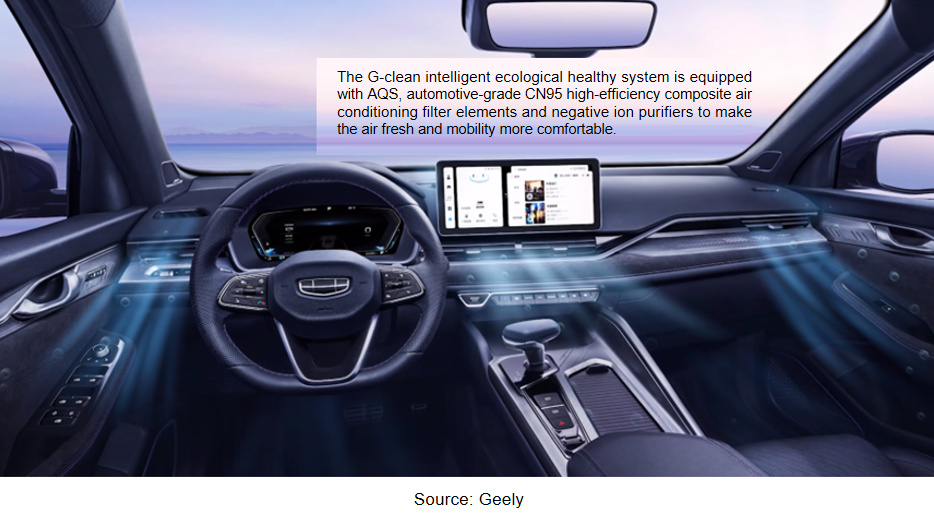
Chinese standards for monitoring and managing in-car air quality include the national standard GB/T 27630-2011 "Guideline for Air Quality Assessment of Passenger Car", the association standard " Passenger Cars - In-car Air Quality Measurement and Odor Evaluation Methods", the industrial standard QC/T 998-2023 "Cabin Air Filter for Automobiles", the association standard "Testing Specifications for Automotive Fragrance Capsules", the association standard "Technical Specifications for Automotive Fragrance Systems” and the association standard “Key Chemical Substances Controlled by REACH in the Automotive Industry Part 2: Testing Specifications".
In the aspect of air quality health certification, besides the CN95 healthy cockpit certification of China Automotive Technology & Research Center (CATARC) & CAQC (by the particle filtration efficiency index of automotive air conditioner filters, the certified products are divided into five grades: CN60, CN70, CN80, CN90 and CN95, of which CN95 is the highest grade, that is, the filtration efficiency of 0.3μm non-oily particles exceeds 95%), there is also "China Automotive Health Index" introduced by China Automotive Engineering Research Institute Co., Ltd. (CAERI), covering five evaluation dimensions, namely, volatile organic compounds (VOC), vehicle odor intensity (VOI), electromagnetic radiation (EMR), particulate matter (PM) and vehicle allergy risk (VAR).
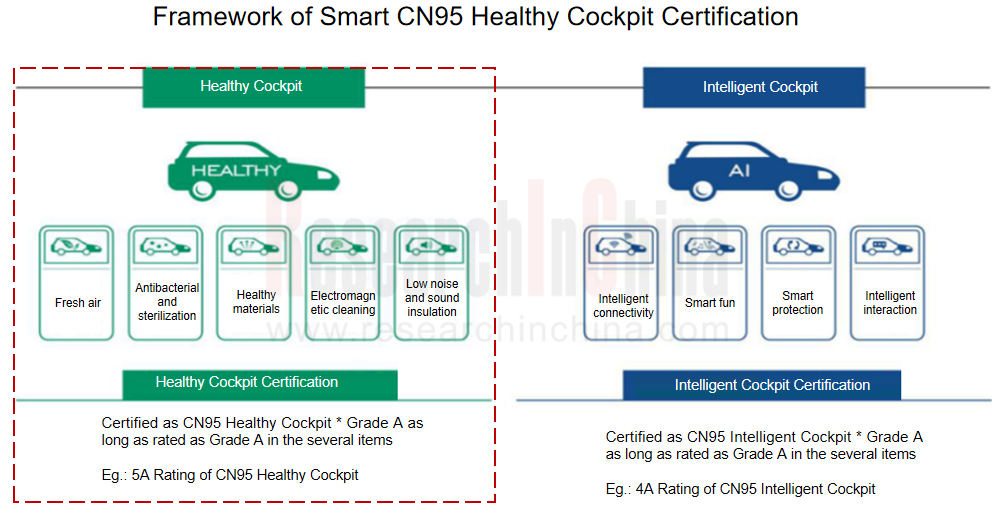 ??
??
1. The installations of automotive air conditioning devices have increased, especially automotive fragrance having seen exponential growth.
At present, automotive air conditioning devices mainly include fragrance systems, air purifiers, PM2.5 filter devices and negative ion systems.
From 2021 to May 2024, the installations of automotive air purifiers and fragrance systems rose rapidly. In 2023, 821,000 cars were equipped with fragrance systems as standard; from January to May 2024, fragrance systems as a standard configuration were installed in 489,192 cars, a year-on-year spike of 122%. It is expected that over 1.1 million cars will carry such systems in 2024.
Meanwhile, the installations of air purifiers made steady growth. It increased by 14.8% year on year in 2022 and 22.4% year on year in 2023 as standard. From January to May 2024, 2.451 million vehicles were equipped with air purifiers as standard, a year-on-year increase of 7.8%. It is expected that air purifiers will be installed in over 7 million vehicles in 2024. From January to May 2024, 6.3336 million vehicles were installed with PM2.5 filters, a year-on-year increase of 12.1%; 1.0256 million vehicles carried negative ion systems, a year-on-year decrease of 5.7%.
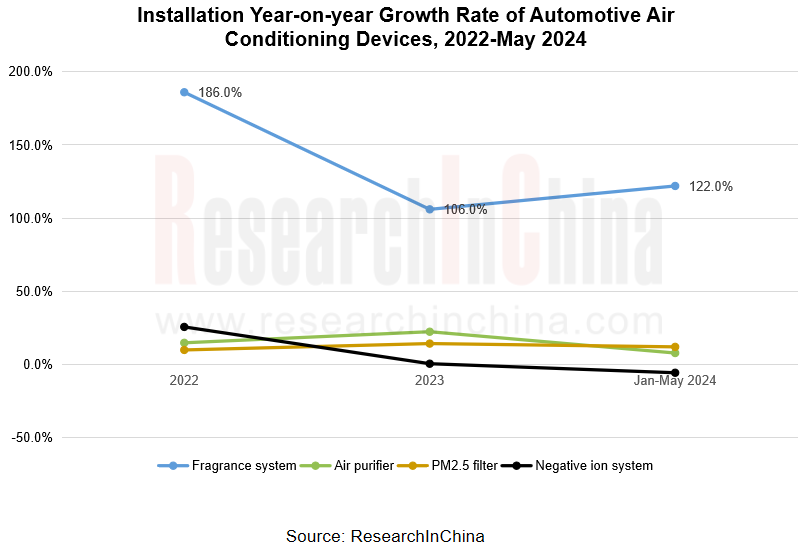
2. Air purification technologies such as photocatalyst and ultraviolet ray are applied to more models.
On mainstream models, air purification systems are mainly used for disinfection and sterilization, for example, plasma purification, photocatalyst purification and ultraviolet sterilization. At present, air purification systems are often matched with air filters to build a complete automotive air purification management system. An automotive air purifier is an air purification device specifically used to purify PM2.5, toxic and harmful gases (formaldehyde, benzene, TVOC, etc.), odor, bacteria, viruses and other in-car pollutants.
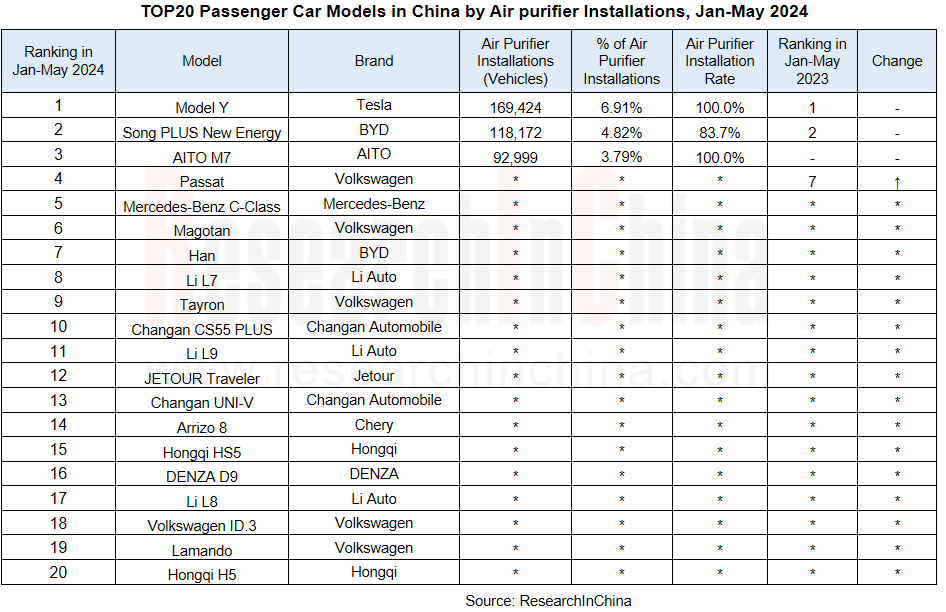
For in-car air purification, ever more OEMs are trying to apply such technologies as ultraviolet disinfection and photocatalyst to improve the in-car air health index, in addition to negative ions/plasma. For example, AITO M9 uses UVC photocatalyst disinfection technology, and the high-configuration model of GAC Toyota Camry is equipped with photocatalyst air purifiers and Panasonic nanoe? X, a nano negative ion air moisturizing purification system.
「Photocatalyst, represented by nanometer titanium dioxide (TiO2), is a collective name for semiconductor materials that does not change under the irradiation of light but can promote chemical reactions and has catalytic function. The biggest feature of photocatalyst is that it strongly absorbs ultraviolet rays in light. After absorbing ultraviolet rays, the molecules of photocatalyst move violently and become active, but its substance remains unchanged. When odorous substances (formaldehyde, acetic acid, ammonia, etc.) in the air pass through the photocatalyst net, they collide with the active photocatalyst, absorb some energy, and become active as well. The molecules move violently and unsteadily, a series of chemical reactions (which are called photodissociation reactions) occur, and the odorous substances are transformed into odorless substances.」
For example, AITO M9 uses a UVC photocatalyst disinfection system combined with air conditioning to not only efficiently filter out tiny particles such as PM2.5 and dust, but also actively eliminate viruses and bacteria in the air conditioning duct and internal air. According to the testing report issued by the authoritative organization “National Center of Quality Inspection and Testing on Air Purification Products”, the photocatalyst air sterilizer assembled into AITO M9 can effectively kill the common influenza virus H1N1, with the removal rate higher than 99.99% within 15 minutes. The killing rate of Staphylococcus albus in 15 minutes goes beyond 99.9%. The extinction rate of natural bacteria in the air surpasses 94% within 30 minutes.
In addition, the principle of ultraviolet disinfection is to destroy the molecular structure of DNA or RNA in microbial cells by using ultraviolet rays with appropriate wavelength, resulting in the death of growing cells and/or regenerative cells, thus accomplishing disinfection. The automotive ultraviolet sterilization systems on market generally adopt the UVC wavelength band (200~275 nm).
3. Fragrance systems are heading in the direction of multimodal control.
The fragrance system releases the fragrance to the whole vehicle through the air conditioning system. The automotive intelligent fragrance system can control the switch according to the settings, and adjust the fragrance concentration, mode and working time interval through various intelligent methods such as WeChat applet, voice control or smart control panel. In general, an automotive intelligent fragrance system is composed of a fragrance container, IVI display, audio control system, fragrance controller and fragrance actuator.
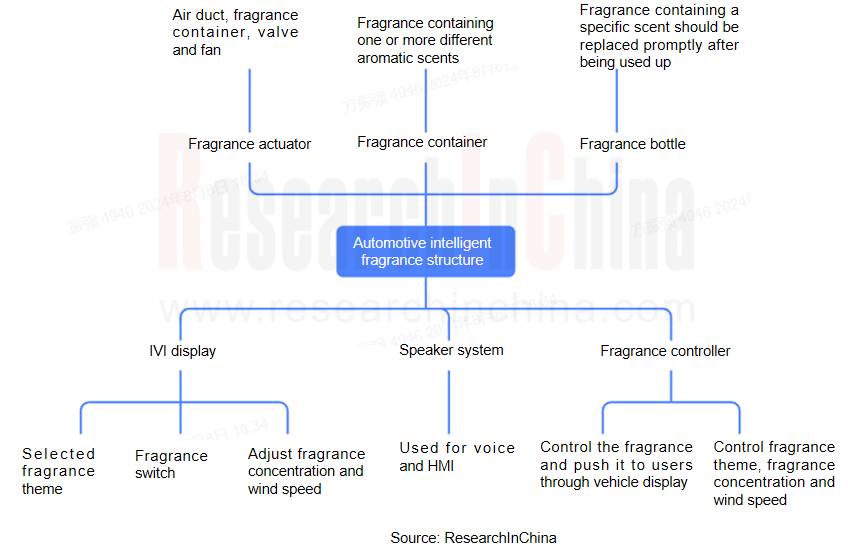
As intelligent cockpit interaction technology develops, multiple control modes for intelligent fragrance systems come out, for example:
Voice control: NIO EC7, Neta GT, HiPhi Y, Voyah Passion, Changan Nevo A07, Livan 7, etc.
Gesture interaction: The intelligent fragrance system of Avatr 11 can be controlled by gesture recognition, emotion recognition, voice interaction and scenario modes.
Face recognition: When a tired driver is detected, NIO EC7 will automatically release the refreshing fragrance.
Remote control: The 2024 Xpeng G9 allows users to remotely turn on/off the air conditioner, adjust the temperature, and select the fragrance scent via their mobile phones. The 2024 AITO M9 lets users remotely turn on/off the air conditioner, adjust the temperature, and tweak the fragrance concentration through via mobile phones. The 2024 Zeekr 001 allows users to remotely turn on/off the air conditioner, adjust the temperature, select the fragrance scent, and tweak the fragrance concentration via mobile phones.
Biometrics: In the future, vehicles will release different scents according to users. For example, the patent issued by Meizu will make the car recognize the user's first odor information for automatic release. A patent issued by BMW can obtain the driver's psychological state by detecting his/her odor to give multiple assists (such as fragrance) or remind the driver, so as to detect whether he/she is tired of driving.
Emotion recognition: Hyundai Motor once unveiled a mini electric vehicle using Emotion Adaptive Vehicle Control (EAVC), a technology which can monitor facial expressions, heart rate and respiratory rate, and combines these readings with input from the vehicle including speed, acceleration, noise and vibration. The technology uses the information to control lighting, climate, music and fragrance dispenser. So far, the Real-time Emotion Adaptive Driving (R.E.A.D.) System has not been applied to the production models of Kia.
4. Automotive olfactory interaction is linked with more scenarios.
In the future, in-vehicle air conditioning is not only about air purification, odor removal and pleasant fragrance, but also about matching the users' application scenario through various scenario modes and intelligently adapting to meet the individual needs of users. In-vehicle olfactory interaction will enable scenario interaction, releasing different scents according to scenarios, for example, releasing appropriate fragrance (e.g., AION LX Plus’ Chinese fragrance) in scenarios with babies or elderly people, and sending out the corresponding scent (e.g., the earthy smell when it is sunny after rain) according to the ambient atmosphere and music style.
 The vehicle monitors the driver's status and reminds him/her via fragrance as soon as tired driving is detected. For example, when the driver is drowsy, the left front A-pillar camera of Livan 7 will capture facial information and give an audio prompt while releasing fragrance.
The vehicle monitors the driver's status and reminds him/her via fragrance as soon as tired driving is detected. For example, when the driver is drowsy, the left front A-pillar camera of Livan 7 will capture facial information and give an audio prompt while releasing fragrance.
 ?When the user plays game, the combination of AR+fragrance can provide a better gaming experience; in different weather and seasons, corresponding fragrance is provided.
?When the user plays game, the combination of AR+fragrance can provide a better gaming experience; in different weather and seasons, corresponding fragrance is provided.
 Fragrance can be linked with various scenario modes. In Nevo A07’s case, in the leisure mode, the seat position/massage intensity, windows, fragrance type and concentration, music duration and volume, ambient lighting, etc. can be customized by users.
Fragrance can be linked with various scenario modes. In Nevo A07’s case, in the leisure mode, the seat position/massage intensity, windows, fragrance type and concentration, music duration and volume, ambient lighting, etc. can be customized by users.
Autonomous Driving Domain Controller and Central Computing Unit (CCU) Industry Report, 2025
Research on Autonomous Driving Domain Controllers: Monthly Penetration Rate Exceeded 30% for the First Time, and 700T+ Ultrahigh-compute Domain Controller Products Are Rapidly Installed in Vehicles
L...
China Automotive Lighting and Ambient Lighting System Research Report, 2025
Automotive Lighting System Research: In 2025H1, Autonomous Driving System (ADS) Marker Lamps Saw an 11-Fold Year-on-Year Growth and the Installation Rate of Automotive LED Lighting Approached 90...
Ecological Domain and Automotive Hardware Expansion Research Report, 2025
ResearchInChina has released the Ecological Domain and Automotive Hardware Expansion Research Report, 2025, which delves into the application of various automotive extended hardware, supplier ecologic...
Automotive Seating Innovation Technology Trend Research Report, 2025
Automotive Seating Research: With Popularization of Comfort Functions, How to Properly "Stack Functions" for Seating?
This report studies the status quo of seating technologies and functions in aspe...
Research Report on Chinese Suppliers’ Overseas Layout of Intelligent Driving, 2025
Research on Overseas Layout of Intelligent Driving: There Are Multiple Challenges in Overseas Layout, and Light-Asset Cooperation with Foreign Suppliers Emerges as the Optimal Solution at Present
20...
High-Voltage Power Supply in New Energy Vehicle (BMS, BDU, Relay, Integrated Battery Box) Research Report, 2025
The high-voltage power supply system is a core component of new energy vehicles. The battery pack serves as the central energy source, with the capacity of power battery affecting the vehicle's range,...
Automotive Radio Frequency System-on-Chip (RF SoC) and Module Research Report, 2025
Automotive RF SoC Research: The Pace of Introducing "Nerve Endings" such as UWB, NTN Satellite Communication, NearLink, and WIFI into Intelligent Vehicles Quickens
RF SoC (Radio Frequency Syst...
Automotive Power Management ICs and Signal Chain Chips Industry Research Report, 2025
Analog chips are used to process continuous analog signals from the natural world, such as light, sound, electricity/magnetism, position/speed/acceleration, and temperature. They are mainly composed o...
Global and China Electronic Rearview Mirror Industry Report, 2025
Based on the installation location, electronic rearview mirrors can be divided into electronic interior rearview mirrors (i.e., streaming media rearview mirrors) and electronic exterior rearview mirro...
Intelligent Cockpit Tier 1 Supplier Research Report, 2025 (Chinese Companies)
Intelligent Cockpit Tier1 Suppliers Research: Emerging AI Cockpit Products Fuel Layout of Full-Scenario Cockpit Ecosystem
This report mainly analyzes the current layout, innovative products, and deve...
Next-generation Central and Zonal Communication Network Topology and Chip Industry Research Report, 2025
The automotive E/E architecture is evolving towards a "central computing + zonal control" architecture, where the central computing platform is responsible for high-computing-power tasks, and zonal co...
Vehicle-road-cloud Integration and C-V2X Industry Research Report, 2025
Vehicle-side C-V2X Application Scenarios: Transition from R16 to R17, Providing a Communication Base for High-level Autonomous Driving, with the C-V2X On-board Explosion Period Approaching
In 2024, t...
Intelligent Cockpit Patent Analysis Report, 2025
Patent Trend: Three Major Directions of Intelligent Cockpits in 2025
This report explores the development trends of cutting-edge intelligent cockpits from the perspective of patents. The research sco...
Smart Car Information Security (Cybersecurity and Data Security) Research Report, 2025
Research on Automotive Information Security: AI Fusion Intelligent Protection and Ecological Collaboration Ensure Cybersecurity and Data Security
At present, what are the security risks faced by inte...
New Energy Vehicle 800-1000V High-Voltage Architecture and Supply Chain Research Report, 2025
Research on 800-1000V Architecture: to be installed in over 7 million vehicles in 2030, marking the arrival of the era of full-domain high voltage and megawatt supercharging.
In 2025, the 800-1000V h...
Foreign Tier 1 ADAS Suppliers Industry Research Report 2025
Research on Overseas Tier 1 ADAS Suppliers: Three Paths for Foreign Enterprises to Transfer to NOA
Foreign Tier 1 ADAS suppliers are obviously lagging behind in the field of NOA.
In 2024, Aptiv (2.6...
VLA Large Model Applications in Automotive and Robotics Research Report, 2025
ResearchInChina releases "VLA Large Model Applications in Automotive and Robotics Research Report, 2025": The report summarizes and analyzes the technical origin, development stages, application cases...
OEMs’ Next-generation In-vehicle Infotainment (IVI) System Trends Report, 2025
ResearchInChina releases the "OEMs’ Next-generation In-vehicle Infotainment (IVI) System Trends Report, 2025", which sorts out iterative development context of mainstream automakers in terms of infota...